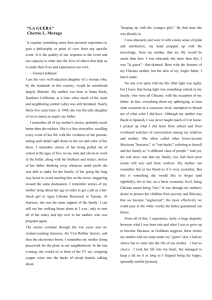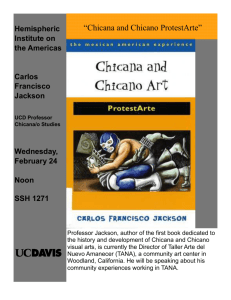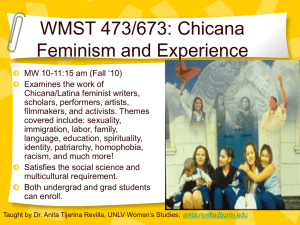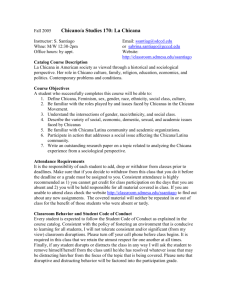An Interview with Denise Chávez
advertisement
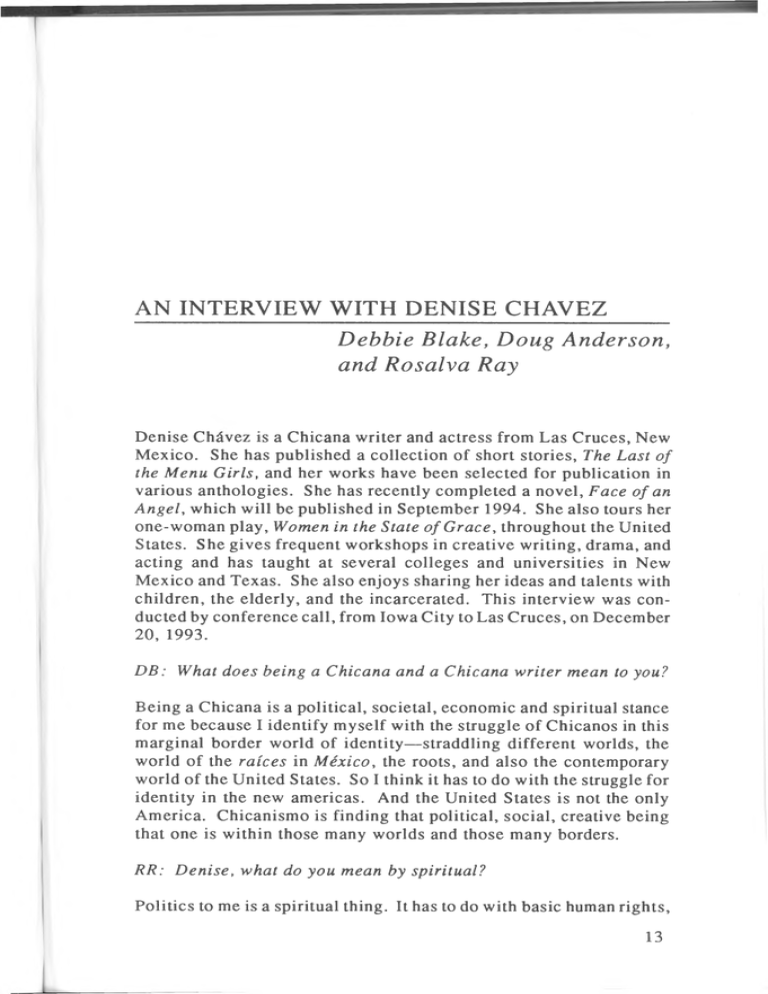
AN INTERVIEW WITH DENISE CHAVEZ Debbie Blake , Doug Anderson , and Rosalva Ray Denise Chavez is a Chicana writer and actress from Las Cruces, New Mexico. She has published a collection of short stories, The Last o f the Menu Girls, and her works have been selected for publication in various anthologies. She has recently completed a novel, Face o f an A n g e l, which will be published in September 1994. She also tours her one-woman play, Women in the State o f Grace, throughout the United States. She gives frequent workshops in creative writing, drama, and acting and has taught at several colleges and universities in New Mexico and Texas. She also enjoys sharing her ideas and talents with children, the elderly, and the incarcerated. This interview was con­ ducted by conference call, from Iowa City to Las Cruces, on December 2 0 ,1 9 9 3 . DB: What does being a Chicana and a Chicana writer mean to you? Being a Chicana is a political, societal, economic and spiritual stance for me because I identify myself with the struggle of Chicanos in this marginal border world of identity— straddling different worlds, the world of the raices in M exico, the roots, and also the contemporary world of the United States. So I think it has to do with the struggle for identity in the new americas. And the United States is not the only America. Chicanismo is finding that political, social, creative being that one is within those many worlds and those many borders. RR: D e n ise, what do you mean by spiritual? Politics to me is a spiritual thing. It has to do with basic human rights, 13 the rights of men and women and children. So when I identify myself as a Chicana writer it is the lifeblood of who I am, which is the spirit that I am. I d on ’t separate myself spiritually, emotionally, physically. I ’m a composite of all those things and to me that is the Chicana spirit. RR: That sounds mystical. It is. RR: What is your relationship to the mystical writers o f Spain? We have to remember where our roots are. Remember that the Chicanos are this mestizaje. We are a mixture of several worlds; a mixture bubbling up to form some kind of new nourishment. We are new beings that come out of all of those old ways of being and existing. We are the new stock from the old soup. DB: The Spanish roots are well-known. Can you describe the indigenous connection that is another element o f the mestizaje? To say that one is mexicana has to do with the indigenous people of Mexico. We are connected to the indios and indias as part of the mestizaje. Here, in Nuevo M exico, one feels that very closely because we have various Indian customs here. As a matter of fact, just a few days ago we celebrated the feast of Our Lady of Guadalupe. It’s a matter of geography. W e ’re talking about indigenous ancestry, but also ancestry to the land which is an indigenous idea to me. RR: What advantages or disadvantages do you see in being grouped together with other Chicana fem in ist writers? And how do you differ fro m those writers? I can not see any disadvantages in being who you are in the time that you are. I see myself as a woman, a feminist. I ’m a Chicana and a Mexican American. I ’m a sister, daughter, those many faces that I ’m trying to deal with in my new novel. I can not see any disadvantages in being who you are. As far as the other writers, I feel a great solidarity with them— Cherrfe Moraga, Sandra Cisneros, Ana Castillo and others as well. Whether we come from urban areas or California, whether we grew up in a large city or in the campo. I think the issues are the same. W e ’re dealing with sexuality, border issues, issues of identity, of freedom, w om en’s rights. W e ’re all dealing with the same topics, so there’s a great sense of unity for me. RR: Do you mind being characterized as a Chicana w riter, as opposed 14 to a writer? No, because I am a Chicana. People might limit you because you come from Tejas and New Mexico, but I never felt the limitation. I ’m happy to take on those other essences and beings that I am. If I say I ’m not a Chicana I might as well cut off my arm or my leg. And if I say I ’m not a feminist, well, I might as well cut off my foot. The whole package goes together. DA: Y o u v e mentioned the word “stance” which I f in d very interest­ in g . Yes, i t ’s a position. I t ’s like putting on an overcoat. It’s a banner. DA : Is there any contradiction in that sense o f identity and the sense o f identity that refers to roots, history and heritage? No, I think not. Chicanismo to me is a consciousness. Not everybody is conscious. Some people d o n’t know about Cesar Chavez and the farm workers; some d on ’t know what has happened in other political realms. When I take on that Chicano stance, as I call it, I take on an awareness and a sensitivity and a commitment to issues and that is bound in my cultural rootedness to the earth. But not everybody feels comfortable with that. I think that chicanismo is an evolution of consciousness I have moved through in this transformation of spirit and energy and it has brought me to a point of consciousness about my people, my culture, my heritage. Not everybody comes to this imme­ diately. I c a n ’t tell you the number of people who have changed their names. They have a name like John and then they become Juan. Or people who have grown up not speaking Spanish, but who go back to school to learn Spanish. Now my case was very interesting because my mother was a Spanish teacher. She was always correcting us. Her language was always so beautiful. My father was a man who grew up in the 1920s who was punished for speaking Spanish in the schoolyards. He went on to the Georgetown law school. I believe that somehow in his quest for success he became deracinated. When he came back from Georgetown and Washington, D.C. and that whole world, he had to become this Anglo person, this other personality. I believe there was always a conflict between my parents. My father tried to get ahead, tried to assimilate and my mother taught me the ways of my ancestors, my roots, my language. DA: Your short story, uCompadre,” [in The Last of the Menu Girlsy suggests that it’s not only a search fo r identity but a creation. 15 In the beginning of “Compadre,” /focfo was always trying to distance herself from her family. Her dream was to get away. But in the end of the book, the breaking of the bread with compadre Regino— I refer to him as the priest at the end— she comes back to the things that sh e’s left behind, and that is sacred. DA: Is there any irony in the fa c t that the fo o d at this m eal, this gathering in “C o m p a d r e ” that it comes fr o m a place called a tortilla factory. It could be read as a commercialization o f Chicano and Chicana culture. I t ’s true that people d o n ’t make their own tortillas anymore. Mine always looked like hell. [Laughter] I ’ve even written a poem about making tortillas called “Tilt-A-W hirl.” There was a woman who used to work for us called Emilia, she was a criada, a nursemaid, and helped our family out. One day we went to a carnival and she got on the tilta-whirl with me. She was such a wonderful person, una indita chaparrita with big hands, a short stocky woman. For some reason, the attendant hadn’t attached the metal bar on the ride and I almost died— le t’s say I could have died— because I found myself falling out of this tilt-a whirl ride. Emilia grabbed me. I describe this in the poem. With her great "tortilla hands," she grabbed me. And I talk about her making tortillas. You have to almost be a Zen Buddhist to make a round tortilla. Mine always looked like Cuba. [Laughter] The poem has to do with the fact that here’s this woman from another generation who saved my life. I respected the work of her hands. We d o n ’t make tortillas by hand anymore. But i t ’s still very beautiful to watch if you ’ve ever gone to a tortilla factory. I often used to go with my mother to pick up tortillas. The machines are very interesting. There is one that makes the dough, one that flattens it out. I t ’s quite a process. To me, i t ’s a tender image. I t ’s not a brutal image. Yeah, there is the industrialization of tortillas, but at the same time there is something to be said for tortillas that come out of your own town. DA: I 'm really fascinated by several things you've said. One is the mestizo consciousness. I ’m interested in knowing whether you see parallels between Chicano!Chicana identities and other ethnicities? Yes, absolutely. Remember that the Latino, Chicano, Mexican Ameri­ can writers are following in the footsteps of the African American writers. This has to do with the antepasados, the people who have come before you, who allow you to take the steps you need to take. I always thank the Black writers because they gave me a sense of freedom. People like Richard Wright and Ralph Ellison; The Invisible 16 Man was a really important book. As well as people like Toni Morrison, and Alice Walker who talked about female circumcision. All of these writers and many others w ho’ve come before them, like [Zora Neale] Hurston, are important. Because of them we are all able to step forward. I wait hungrily for the Vietnamese American novel. Where are those voices? T h ey’re emerging, they’re rising up. DB: D e nise, earlier you mentioned the concept o f borders and you live close to the Mexico-U.S. border, a space that has been defined in many different ways. Can you talk about your ideas o f the border? What does it mean to you and how do you integrate it into your work? I live 42 miles from El Paso and Juarez. My mother was a school­ teacher so we always had women here helping us at the house, criadas, caretakers, and ayudantes, helpers. My border is a fluid world. T here’s an invisible membrane, but it’s a comfortable membrane, in which people move back and forth between Mexico and the United States. We were always having people moving through our lives, working with us. I heard both languages all the time. Today I can go outside, step out the door, and find people to help me, work for me. I have many friends from Mexico. My world is not separate. The river is not that far from here. A couple of miles. I live in a border reality and I feel very comfortable in it. I know that some people d o n ’t feel very comfortable. DB: You don t see any conflict occurring, you don t see the border as a separation o f two worlds? There is conflict if you want to see it. The fences are there, you see the people getting all hysterical about the census and the dogs. I was deeply moved by the play by Teatro de la Esperanza, “La Victima.” In the play, a family comes over from Mexico and somehow the son gets separated from his family. He grows up in a different world and at the end of the play he ends up deporting his own mother. I t’s a very profound statement. I have relatives who work for the Immigration and Naturalization Service and who are FBI agents and law enforce­ ment people and it hurts me. It grieves me to know that my own family is sending back my own family, you see what I mean? There is a lot of brutality. That goes without saying. And it goes both ways. I think it has to do with individuals. I do not see it as a violent world. You can see it that way if you want to, but I see the world as a place where there are ugly people and mean people and bad things happen to everyone: mexicanos and Anglos, anyone. Brutality and ugliness exist but that isn ’t the way I choose to live my life. Maybe I ’m too optimistic. I ’m a pendeja in that aspect. I ’m a fool for optimism. I 17 just feel that the border world is where the changes are going to take place. I t ’s at the heart of transformation. I t ’s the place where violence can be turned into something else. Maybe someday we w o n’t even have borders. RR: You put it in a very positive light and I think that1s great but I'm wondering about the representation o f the border as a violent meta­ phor. Specifically, it reminds me o f Octavio P a z ’s use o f the verb rajarse. What does it fe e l like to live in this geographical space— the river, the actual border, the Southwest as a border region. I 'm not thinking o f actual violence, but related to the issues o f identity, the violence o f being ripped apart which is what the verb means. Between the two categories, between two cultures, between two countries. Let me use the metaphor of being ripped. Yes, w e’ve had our skin ripped off. But the wonderful thing is that you can develop new skin. Skin is an organ, unless burned deeply, but even then, one creates new skin. We are people who have new skin, we are this mestizaje, this chicanismo, our skin is new. In that regard, we can be healed. We are the grafted people, so to speak. But there is a great strength in that. Lately, skin metaphors have been very interesting to me. When I think about writing Face o f an Angel, I feel like sometimes my skin has been pulled from me. Some of my writing has been painful. You peel off a piece of skin, but then something grows over it. That area becomes tougher but still feels very deeply. I think that’s the kind of writer that is emerging, that has such power. Yes, there are those hurts and those injuries, but the skin is still hanging together. It has a resilience that is very beautiful. RR: L e t ’s switch the fo c u s fro m Denise Chavez the writer and talk about Denise Chavez the performer. Do you conceive o f these roles as different fro m each other? And do any o f your characters cross over fro m performance to fiction? Mama Lupita from Women in the State o f Grace is a character in Face o f an Angel. When I was in high school, I got involved in theater and I found that I could become someone else, get inside the skin of another like the Mayan priests who used to dance inside the skins of the people. I want to be able to dance within the skins of my characters. To me there’s no separation between myself the writer and myself the actress. DB : Can you explain what is meant by the phrase "state o f grace” in the title o f your one-woman performance? 18 My characters are characters that endure. They are survivors. There is a dignity in their lives, no matter what their lives have been like, whether it’s La Corrie w ho’s a gay bag lady or Magdalena, the welfare mother. I grew up a Catholic and that has permeated my life. There were twelve of us in my graduating class and we referred to ourselves as the Apostolettes. There were 50 girls at Madonna High School. It was a wonderful place to grow up and become a person. But in the back of our minds, we were always looking for that elusive state of grace. I haven’t found it yet. I ’m still looking. [Laughter] DB : Can you expand on the religious symbols in your perform ance, the altar and candles. I know it has a lot o f relevance to Catholicism. Yes, it does but let’s take it even further than that. It has to do with Our Lady of Guadalupe more than Catholicism. She is the standard bearer of the oppressed. Whenever you see marches or huelgas, strikes, or anything to do with the United Farm Workers or any number of other groups, they always have a banner of Our Lady of G uadalupe. She is the representative of the disenfranchised. She is a mestiza herself by birth. S h e’s inbetween the worlds. She comes out of the tradition of Catholicism but she is bigger than that tradition. She has to do with the concept of God being a woman, having more feminine aspects than the traditional Catholic or Protestant angry God with the lightning coming out of his head. I identify her more as a spiritual being in which the mother is the core. The site of Our L ady ’s appearance in Mexico City was the former temple of Tonantzin, who was the goddess of life in death, and death in life. That symbol is charged with a lot of historical and cultural energy. In that way Our Lady of Guadalupe is removed from Catholicism. D B : Yes. And it seems to be identified a great deal with the indigenous people, so there is symbolic relevance there. Yes, I d o n ’t necessarily have to have the figure of Our Lady of Guadalupe [in the performance], I could do it with another goddess image. The important thing is that the goddess is a mother and that sh e’s pregnant with life, which Our Lady of Guadalupe is. S he’s pregnant at the moment she appears.1 S he’s full of life. She’s a mestiza. She’s the unfolding, awakening of life. DB : The two elements o f a womanist context and also an indigenous element seem to overcome or maybe recreate the idea o f religion as something other than the oppressive element that Catholicism was fo r Mexicans and Chicanas fo r many years. 19 It is still to some. Because God has to be a man. Women can not be priests. Catholicism still oppresses women. I agree with you in that interpretation. DB : Wrapping this up now, I ’d like to ask about where you see your work going in the future. You’ve completed your novel, Face of an Angel, which will be published in September, and you are working on a second act fo r Women in the State of Grace. How do you see your work evolving into the future? I think writers are always writing whether they’re writing or not. I ’ve gone through so many photo albums in the last couple of days because I ’ve been looking for certain images. They kind of feed me. One of the projects that I want to work on is stories that come out of the myths of my family. I want to write about my m other’s family which came up from Chihuahua, Mexico and settled in a place called El P o lvo , [Texas] which means the dust. I want to write a book called Rio Grande F am ily, which incorporates some of my ruminations and my thoughts with actual stories of my family. Also, I ’d like to write a biography of my mother who was a wonderful character, and call it La Reina de Las Cruces, The Queen of Las Cruces. In addition to that I ’m thinking about a novel from the point of view of an older man that is a mestizo character. His mother was Anglo and his father was Mexican. There are certain issues that I want to cover. My father has Alzheim er’s [disease] and I want to write from the point of view of an older male character. Probably the most immediate project is to complete the characters that I ’ve been working on for Women in the State o f Grace: Part II. One of them is a gynecological examiner, an LPN. She’s talking to the audience while she’s giving a pap smear. I want to work on projects that are fun and challenging. I want to laugh, to cry, to keep on working. I ’m not tired. Not yet. My work feeds me. Notes 1 According to the legend, Our Lady of Guadalupe appeared to a peasant, Juan Diego, in 1531 and instructed him to tell church officials to build a church in her honor on that site. When church officials refused to believe him, Our Lady of Guadalupe engraved her image on a piece of cloth that Juan Diego was wearing as proof of her visitation. The basilica was built soon after and is visited by thousands of pilgrims and visitors annually. The image of the dark-skinned Virgin represents the Mexican people as mestizos recognizing their mixed heritage of Spanish, Indian and African. 20
